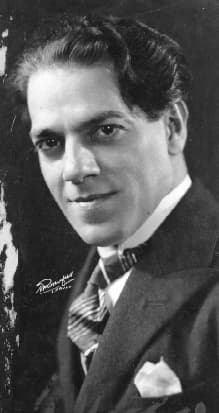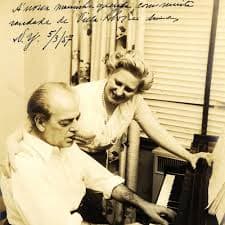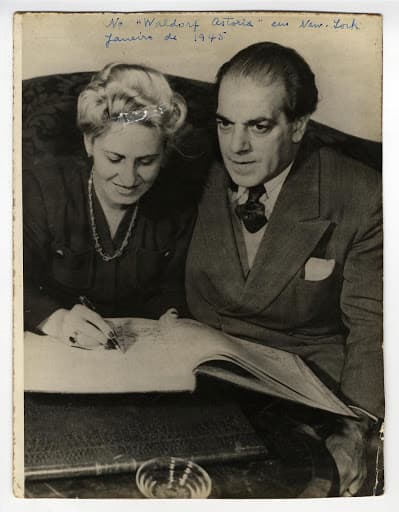Heitor Villa-Lobos (1887-1959) celebrated his seventieth birthday in the Alrae Hotel in New York City on 5 March 1957. The New York Times published a glowing editorial in his honor on 4 March. “Heitor-Villa-Lobos, Brazil’s most famous composer and one of the truly distinguished men of music of our time will be 70 tomorrow. His energy and enthusiasm are undiminished and his creative powers remain at flood tide. He would be a remarkable figure in any age; in his own place and time he has been an enormously influential personality, leading his own people to a broadening of its culture and a rediscovery of its musical roots.”

Heitor Villa-Lobos
On his birthday, Villa-Lobos completed his Twelfth Symphony, the composer’s final work in the genre. The work premiered on 20 April 1958 at the Lisner Auditorium in Washington, D. C., with Howard Mitchell conducting the National Symphony Orchestra.
Heitor Villa-Lobos: Symphony No. 12 “Allegro non troppo” (São Paulo Symphony Orchestra; Isaac Karabtchevsky, cond.)
A critic writes, “The first movement has a buildup not unlike that of a fine Broadway musical… Not in three days have any brass players had the field day the men in the National Symphony enjoyed in Lisner Auditorium last night in both the outer movements of this Symphony. Howard Mitchell led the piece with a brilliant command of its best features. It all had a kind of wide-screen, multilux color effect I thoroughly enjoyed.” The symphony is a compact work, lasting around twenty-five minutes in performance. It is cast in a traditional four-movement layout and featured a more traditional orchestration. A reviewer writes, “The vast lush wind sound is replaced with a more mainstream wind section, yet the percussion section is augmented with tam-tam, cymbals, cocos, and xylophone. The Symphony contains a variety of melodic writing styles but is more Romantic in nature in the outer movements. The central movements are more impressionistic. The result is a kind of synthesis between European style and Latin soul; very enjoyable and rewarding it is too.”
Heitor Villa-Lobos: Symphony No. 12 “Adagio” (São Paulo Symphony Orchestra; Isaac Karabtchevsky, cond.)

Heitor Villa-Lobos and Arminda Neves d’Almeida (Mindinha)
The work is dedicated to Arminda Neves d’Almeida, an accomplished violinist and the composer’s companion for the last 23 years of his life. They had known each other from her student days at the School of Music of the Federal University of Rio de Janeiro, an institute administrated by Villa-Lobos. Mindinha, as she was affectionately nicknamed, had been in love with Heitor for an extended period of time. However, it was only in 1936 when Villa-Lobos separated from his wife, the pianist Lucília Guimarães that the relationship started in earnest. With strict divorce laws governing Brazil at that time, Villa-Lobos was never able to marry Mindinha, even though he made countless legal requests for divorce. Villa-Lobos was anxious to marry Arminda to normalize her legal position, but the courts always rejected his petitions. Villa-Lobos dedicated more than 50 of his works to Mindinha, and 3 years after his death she writes to Marguerite Long, “You can understand how I feel, without the one who represented everything to me: my immense love, my mentor, my friend, and how difficult it is to live.” However, her influence did not end with Villa-Lobos’s death in 1959 as she established the “Museu Villa-Lobos” and helped to run the organization until her death in 1985.
Heitor Villa-Lobos: Symphony No. 12 “Scherzo” (São Paulo Symphony Orchestra; Isaac Karabtchevsky, cond.)

Villa-Lobos and Mindinha
In his Symphony No. 12, Villa-Lobos brings together “the symphonic craftsmanship of the great masters and a typical explosion of energy, unusual harmonic patterns, rhythmic restlessness and a fondness for free counterpoint and symmetrical figurations.” The opening movement is economically scored and explores the possibilities for thematic development, while the “Adagio” has an anxious and solemn quality that combines rich counterpoint with quartal and chromatic harmonies. Brilliant orchestration reigns in the “Scherzo,” with the central section sounding a somewhat oriental flavor. Scored as a rondo, the concluding movement features a military-style theme propelled by an extraordinarily active bass line. A critic writes, “In his final symphony, Villa-Lobos delights in a sea of themes and sounds, and flings them generously in the direction of the listeners, to quote his own words, in the form of “letters written to posterity without expecting a reply.”
For more of the best in classical music, sign up to our E-Newsletter
Heitor Villa-Lobos: Symphony No. 12 “Molto allegro” (São Paulo Symphony Orchestra; Isaac Karabtchevsky, cond.)
